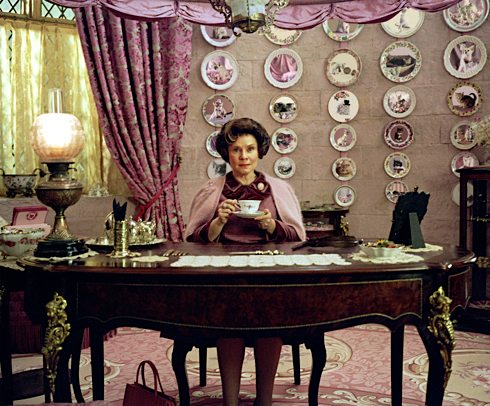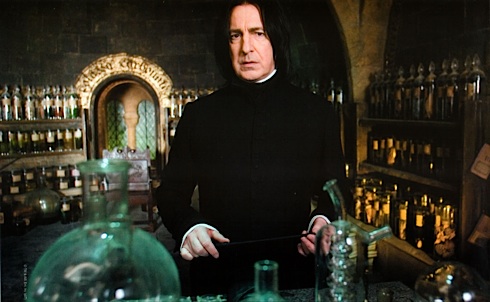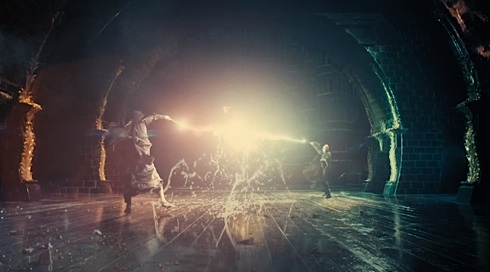Of all the books in the series, I probably have the most complicated relationship with Harry Potter and the Order of the Phoenix. While it drives me insane that the longest book in the series is the one where Harry is going through his most frustrating phase, it’s nonetheless necessary that he learn to deal with the anger of adolescence. Unfortunately, this leads to very long passages of Harry sulking or yelling at people, and worse, thinking that he’s unlocked All The Answers. He spends the entire book convinced that because he’s the one who’s ultimately going to have to take on Voldemort, that any risk whatsoever to any of his friends and loved ones is unacceptable, and that he must act completely alone. The certitude of adolescence, of that point in one’s life when one is so close to adult perspective and yet due to one tiny but fatal flaw so far away, blinds Harry to the fact that this isolation is exactly what Voldemort wants him to feel, and that his resolute insistence on going it alone plays right into Voldemort’s hands. Fortunately, at the end of the book, after Harry plays into Voldemort’s hands for 800+ pages, he realizes what he’s done wrong, and the endgame of Half-Blood Prince and Deathly Hallows sees a much wiser, more collaborative Harry.
Really, the greatest frustration caused by Order of the Phoenix is that it takes so long for Harry to come to what, for most post-adolescents, is an incredibly obvious solution. The book is a better artistic achievement for this, in a roundabout, counter-intuitive way, though what makes it work as a book is precisely what would doom too faithful a cinematic adaptation. The producers, as well as new screenwriter Michael Goldenberg (taking over for Steve Kloves, who wrote the first four) and director David Yates, realized that Order of the Phoenix needed to be shorter as a movie than it was as a book. And it’s the shortest movie in the series. But it could almost stand to be longer.
Order of the Phoenix was the first movie I missed in theaters, for a variety of not terribly interesting reasons, and I watched it on TV a couple years later. That viewing was a little disorienting. I kept getting the sense that scenes had been edited for television, then I remembered I was watching it on cable. I was confused watching the movie, and I’d read the book. The movie moved, but aside from the broad strokes of Harry vs. Voldemort, very little else made a ton of sense.

On second viewing, for this rewatch, the movie wasn’t much more coherent. What I realized was that its narrative lacunae weren’t due to carelessness in Goldenberg’s adaptation, but in a miscalculation as to how much subtlety he and Yates could get away with. For Yates’ part, he does an outstanding job directing, even down to details like a confrontation between McGonagall (Maggie Smith) and Umbridge (Imelda Staunton) on a staircase, where the much smaller Staunton inches up the stairs as she asserts her authority over Smith, whose retort brings her up a step to tower over Staunton again, only to have Staunton exercise her executive privilege, ending up 2-3 steps higher.
The performances are better than they are in any other movie in the series. Daniel Radcliffe’s Harry—who’s been mourning the death of Cedric Diggory by getting a haircut and lifting weights, apparently—is more assured than he’s been in any movie in the series, and he’s spectacularly good at getting Harry’s frustration and anger across without sinking into the Emo Harry abyssal into which lesser actors would disappear, never to be seen acting well again. And no matter how repetitive it gets to say “Alan Rickman is awesome” in every one of these rewatch write-ups, it must be said again and again: Alan Rickman is awesome. He manages to be funny and yet still be Snape; he’s particularly good in his private lessons with Harry.

Of the newcomers, the great George Harris (whom you may know as Katenga in Raiders of the Lost Ark, one of the finest brief supporting performances ever) has little to do as Kingsley Shacklebolt, and Natalia Tena even less as Tonks, but Imelda Staunton commands the movie as Ministry of Magic avatar Dolores Umbridge. She is so loathsome, and every detail of her performance (down to the meowing portraits of cats in her office like the talkative paintings of deceased Hogwarts headmasters in Dumbledore’s office….think about that for a second, but not too long) evokes shuddering horror, culminating in her line “I really hate children,” right before being carried off into the woods by the centaurs. Her performance is so good (and so faithful to Umbridge’s portrayal in the book) that it’s only later that it dawns on you how absent Dumbledore is in this movie. The book features some of Dumbledore’s most dramatic moments, and establishes him as a man of considerable swagger. In the movie, Michael Gambon makes the mistake of remaining true to the horribly misguided choices he made (or that were made for him) in the horrific Goblet of Fire. Shouty Dumbeldore is less on display in Order of the Phoenix, but he still barks at the students to study once. Dumbledore does not bark at students. It is simply not done.
Order of the Phoenix is, despite an occasional excess of confidence that its entire audience has read the book multiple times, a step up from Goblet of Fire. It may not be terribly coherent, but it at least moves, and until the uninspired visual effects take over during the climax, it’s visually compelling. Goblet of Fire was incoherent, had uninspired visual effects, and plodded. So, small steps, and while the bar is quite low, Order of the Phoenix is still the second-best of the first five movies, after Prisoner of Azkaban. Also, it has Luna Lovegood, and that immediately makes it good. LOVEGOOD.
Danny Bowes is a playwright, filmmaker and blogger. He is also a contributor to nytheatre.com and Premiere.com.










